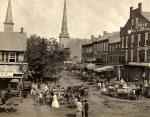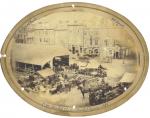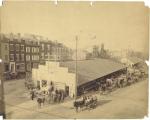![header=[Marker Text] body=[For over a century, farm produce was sold here in market sheds and from wagons at the curbs. The first sheds were built soon after the city was laid out in 1785; the last were removed in 1889. Many inns faced the Square.] sign](http://explorepahistory.com/kora/files/1/10/1-A-2E-139-ExplorePAHistory-a0a5e8-a_450.gif)
Mouse over for marker text
Name:
Market Square
Region:
Hershey/Gettysburg/Dutch Country Region
County:
Dauphin
Marker Location:
S. Market Square (E side), Harrisburg
Dedication Date:
February 25, 1953
Behind the Marker
Most Americans living in the twenty-first century shop in supermarkets where a dozen or more aisles contain mountains of fresh produce and meat, banks of frozen foods, and foodstuffs from around the nation and the world, displayed in a bright, clean, climate-controlled, and sanitary environment. But before industrialization transformed Americans' lives, every city, town, and village in Pennsylvania and the nation had its own out-door market where people bought locally and regionally grown produce. Usually situated in the middle of town, the markets of pre-industrial America were places where neighbors and people from the surrounding area sold goods grown and made on their farms. Harrisburg's Market Square was one of these places.
Harrisburg's history began when English immigrant John Harris started a ferry across a natural ford on the Susquehanna River in the early 1700s. Soon, Harris' ferry became a main passageway between the settled eastern seaboard and the distant regions of the western interior, and the site of his ferry a center of commerce for Native Americans, fur traders, and trappers. When the town of Harrisburg was laid out in 1785, its founder designated the intersection of Market and Second Streets as the site for Market Square - conveniently located near the river crossing so people from the surrounding farms could easily bring their produce into town by boat or by wagon.
In the days before refrigeration, urban Americans typically shopped for perishables two times a week. In Harrisburg, market days were Wednesdays and Saturdays. By the 1840s, vendors came from the surrounding counties to Harrisburg's Market Square. Some lived nearby, like David Hummel who lived just off the square and sold milk on market days. Others arrived the day before and stayed overnight in one of the hotels located on the square. "Pap" Herrick, who came "from over the river" with his daughter and a wagonload of chickens and produce, always arrived Tuesday or Friday night and stayed at the Washington Hotel. Other vendors came down the Susquehanna in arks or boats to sell their fish or produce.
Shoppers knew that they had to come to "the sheds" early if they were to get the freshest food. In 1899, "Harrisburger" Theodore B. Klein recalled the incredible variety of edibles available in the market when he was a boy: "Smear Kase" (cream cheese), apple butter, eels, "catties"(catfish), shad, beef, mutton, pork, apples, peaches, pears, plums, sausages, puddings, butter, eggs, "small beer," mead, gingerbread, cookies, candy mint sticks, and sour drops. Two times a week, a parade of housekeepers came from all over town between four and nine o'clock in the morning to keep their pantries well stocked with provisions.
While vendors sold all sorts of foodstuff on regular market days, butchers had an early morning meat market every day. They transported whole quarters of beef or pork in wheelbarrows into the market house and made cuts to order. After filling a customer's request, the butcher wrapped the order in paper tied with string, or hung the meat on "skivers," large dowels or "pins" made of hickory wood, upon which the customer carried the order home.
By the mid 1800s, Pennsylvania had been carved into regional hinterlands, each with its own network of commercial centers. Food came to cities and towns from outlying areas in a wide variety of ways. Drovers walked herds of cattle, sheep, and pigs, and flocks of geese and turkeys to local slaughterhouses; wagoneers came on Conestoga wagons pulled by teams of draft horses; canal and river boatmen brought all kinds of produce in boats and arks. Centrally located in town and a prominent feature on the landscape that everybody knew, food markets also became the site for civic events. Here they gathered for political rallies, firemen's musters, election night bonfires, and other civic events. At Market Square the residents of Harrisburg came to see and listen to the great heroes of the day: President George Washington, Revolutionary War hero the Marquis De Lafayette, Daniel Webster, Abraham Lincoln, and General Ulysses S. Grant all spoke at Market Square.
Conestoga wagons pulled by teams of draft horses; canal and river boatmen brought all kinds of produce in boats and arks. Centrally located in town and a prominent feature on the landscape that everybody knew, food markets also became the site for civic events. Here they gathered for political rallies, firemen's musters, election night bonfires, and other civic events. At Market Square the residents of Harrisburg came to see and listen to the great heroes of the day: President George Washington, Revolutionary War hero the Marquis De Lafayette, Daniel Webster, Abraham Lincoln, and General Ulysses S. Grant all spoke at Market Square.
Revolutionary changes in agriculture, industry, and transportation forced nineteenth century Americans to adapt to new conditions. Like Philadelphia, Pittsburgh, and other Pennsylvania cities, Harrisburg became increasingly industrialized and its population skyrocketed. Now sprawling cities had to develop new, more effective marketing systems to feed their growing numbers of inhabitants, and to handle the exploding volume of food arriving in refrigerated train cars from the farms of the American west and south.
To survive, many Pennsylvania farm families concentrated on the production of eggs, milk, or more perishable fruits and vegetables, such as tomatoes, that did not travel well. Unable to offer the variety or prices of the specialty retailers, the old open-air markets like Harrisburg's Market Square were thought to be obsolete. In 1889 the city tore down the market sheds to make way for trolley car tracks. By the early 1900s Harrisburg residents could take "street cars" to bakeries, butcher shops, fish markets, greengrocers, and grocery stores that sold oranges from Florida, figs and prunes California, beef from the Midwest, cheese from New York, and bananas from South America.
In the late 1900s, American foodways changed yet again. A revival of interest in backyard gardening and locally grown organic produce created opportunities for the creation of new farmers" markets. Today people can buy and sell locally grown produce at Harrisburg's Broad Street Market, one of the thousands of "farmer's markets" that have emerged across the Commonwealth and the nation.
Harrisburg's history began when English immigrant John Harris started a ferry across a natural ford on the Susquehanna River in the early 1700s. Soon, Harris' ferry became a main passageway between the settled eastern seaboard and the distant regions of the western interior, and the site of his ferry a center of commerce for Native Americans, fur traders, and trappers. When the town of Harrisburg was laid out in 1785, its founder designated the intersection of Market and Second Streets as the site for Market Square - conveniently located near the river crossing so people from the surrounding farms could easily bring their produce into town by boat or by wagon.
In the days before refrigeration, urban Americans typically shopped for perishables two times a week. In Harrisburg, market days were Wednesdays and Saturdays. By the 1840s, vendors came from the surrounding counties to Harrisburg's Market Square. Some lived nearby, like David Hummel who lived just off the square and sold milk on market days. Others arrived the day before and stayed overnight in one of the hotels located on the square. "Pap" Herrick, who came "from over the river" with his daughter and a wagonload of chickens and produce, always arrived Tuesday or Friday night and stayed at the Washington Hotel. Other vendors came down the Susquehanna in arks or boats to sell their fish or produce.
Shoppers knew that they had to come to "the sheds" early if they were to get the freshest food. In 1899, "Harrisburger" Theodore B. Klein recalled the incredible variety of edibles available in the market when he was a boy: "Smear Kase" (cream cheese), apple butter, eels, "catties"(catfish), shad, beef, mutton, pork, apples, peaches, pears, plums, sausages, puddings, butter, eggs, "small beer," mead, gingerbread, cookies, candy mint sticks, and sour drops. Two times a week, a parade of housekeepers came from all over town between four and nine o'clock in the morning to keep their pantries well stocked with provisions.
While vendors sold all sorts of foodstuff on regular market days, butchers had an early morning meat market every day. They transported whole quarters of beef or pork in wheelbarrows into the market house and made cuts to order. After filling a customer's request, the butcher wrapped the order in paper tied with string, or hung the meat on "skivers," large dowels or "pins" made of hickory wood, upon which the customer carried the order home.
By the mid 1800s, Pennsylvania had been carved into regional hinterlands, each with its own network of commercial centers. Food came to cities and towns from outlying areas in a wide variety of ways. Drovers walked herds of cattle, sheep, and pigs, and flocks of geese and turkeys to local slaughterhouses; wagoneers came on
Revolutionary changes in agriculture, industry, and transportation forced nineteenth century Americans to adapt to new conditions. Like Philadelphia, Pittsburgh, and other Pennsylvania cities, Harrisburg became increasingly industrialized and its population skyrocketed. Now sprawling cities had to develop new, more effective marketing systems to feed their growing numbers of inhabitants, and to handle the exploding volume of food arriving in refrigerated train cars from the farms of the American west and south.
To survive, many Pennsylvania farm families concentrated on the production of eggs, milk, or more perishable fruits and vegetables, such as tomatoes, that did not travel well. Unable to offer the variety or prices of the specialty retailers, the old open-air markets like Harrisburg's Market Square were thought to be obsolete. In 1889 the city tore down the market sheds to make way for trolley car tracks. By the early 1900s Harrisburg residents could take "street cars" to bakeries, butcher shops, fish markets, greengrocers, and grocery stores that sold oranges from Florida, figs and prunes California, beef from the Midwest, cheese from New York, and bananas from South America.
In the late 1900s, American foodways changed yet again. A revival of interest in backyard gardening and locally grown organic produce created opportunities for the creation of new farmers" markets. Today people can buy and sell locally grown produce at Harrisburg's Broad Street Market, one of the thousands of "farmer's markets" that have emerged across the Commonwealth and the nation.
Beyond the Marker








